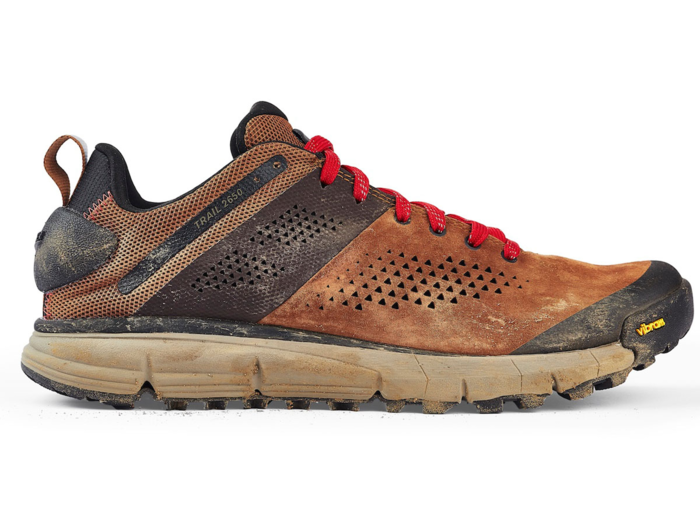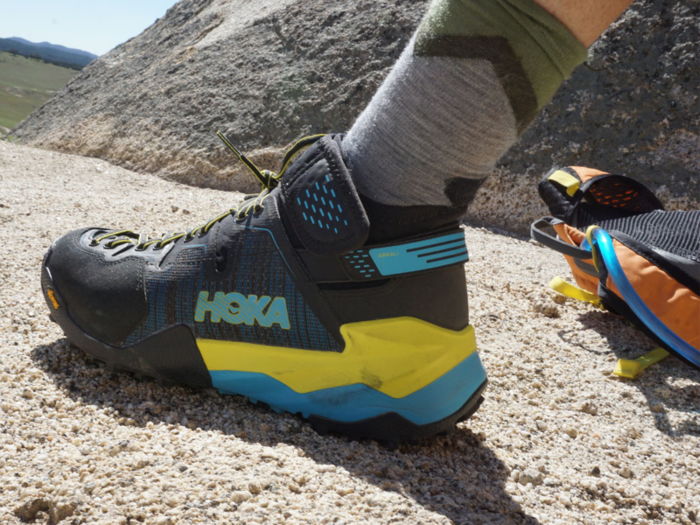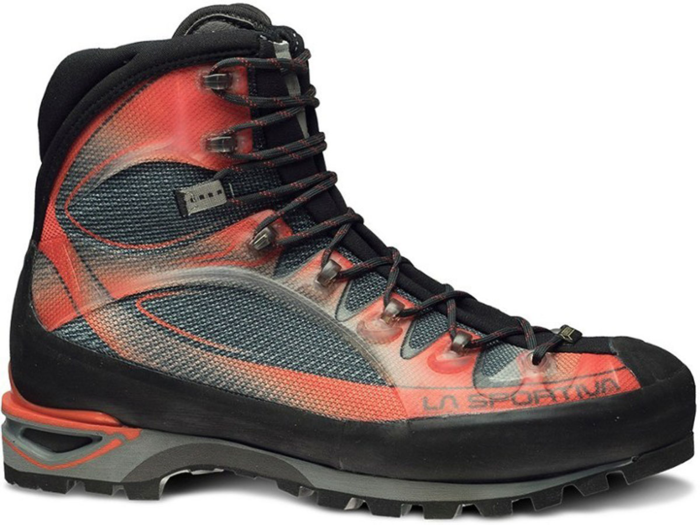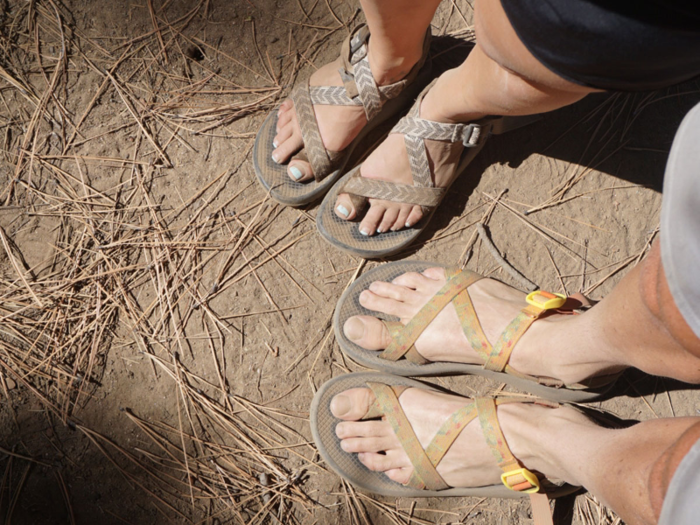- Home
- slideshows
- miscellaneous
- The best hiking boots and trail shoes for men
The best hiking boots and trail shoes for men
The best men's classic hiking boot overall

The best men's shoe for summer hiking

When we think of hiking footwear, most of us default to boots. If you were planning on setting off on the Pacific Crest Trail tomorrow, chances are you would go out today and buy the sturdiest boots you could, right? It turns out that many hikers have moved away from the sturdy boot to something lighter which is easier to pick up thousands of times and dries much faster when rivers have to be crossed. If you're considering some summer hiking, shoes might make a great choice.
Danner is one of the biggest names in boot-making, and they have gained a following for their classic looks and modern flair. The Trail 2650 is a big departure for them: It's a below-the-ankle hiking shoe that is designed to be both lightweight and breathable. Over the 2,650 miles of the Pacific Crest Trail, a hiker lifts their feet millions of times, meaning that a lightweight shoe makes the trip a lot easier. Often, seasoned hikers have taken to trail running shoes, which are super light but don't offer much support. The Trail 2650 aims to offer the benefits of a trail runner with more durability, stiffness, and longevity. As The Manual noted, "The lightweight upper, combined with an ultra-lightweight EVA midsole and Danner's Trailguard platform, make the Trail 2650 both extremely light and comfortable."
Even if you're not getting out on a months-long expedition, the sneaker-like fit and breathable material will feel more familiar if you're a beginner hiker. These shoes just launched, so there aren't many reviews out there yet. But I have been kicking rocks and walking to the shops in them for about a month, and I'm satisfied that they deliver the lightweight feel of a trail runner in a more robust package.
The EXO heel, a supportive area around the bottom of the ankle that locks the heel in the shoe, means that I was able to hike long days right out of the box in these shoes without any blisters. I also didn't feel out of place wearing them with jeans at the bar afterward, so that's a win for anyone who doesn't live in a mountain town where outdoor gear is the norm.
Pros: Lightweight and fast-drying, durable and stiff
Cons: Won't offer as much ankle support on rocky trails
The best men's high-ankle hiking/approach shoe

Approach shoes are a rather nebulous category. They have to be light enough to carry once they are not in use, but robust enough to support hikes across the boulder-strewn and steep approaches to technical rock climbs.
Compromise is normally the key, and a lot of approach shoes really only serve a singular purpose. Hiking brands make shoes that are a little too heavy, and climbing brands make shoes a little too light and flimsy. Where the Hoka One One Sky Arkali wins out is that it isn't just light enough to haul up a climb, it's also supportive enough to be your all-around trail shoe. That's because it comes from neither a hiking nor a climbing brand, but rather a sneaker company famous for well-cushioned and supportive running shoes.
I love how the Arkali feels like a sneaker but with the added support of a boot. Unlike most boots, which use laces for all fit adjustments, the Arakali uses a Velcro ankle support and heel strap in addition to a lace. This means you can dial in tightness where you need it without overcompressing other parts of your foot. At 15 ounces for the pair, these boots feel more like sneakers and do a lot of what trail runners do, which is weigh less and dry quickly.
Unlike trail runners, they'll keep your ankles supported on rocky and steep terrain. The midsole is more responsive than heavier boots because it is essentially taken from a sneaker, making the Arkali great for scrambling up steep terrain. But as should be obvious with a boot this light and breathable, they are less than ideal in deep snow.
The looks of this boot may be polarizing, but that's OK. If you can get past the neon blue and yellow, you'll be very happy with the grip provided by that Vibram branded sole.
Gear Junkie said the Arkali performs on trails and near vertical rock thanks to its grippy sole and innovative combination of technologies from climbing, hiking, and running. At first, the combination of a running midsole, adjustable ankle wrap, and reinforced toe box seems odd. But wearing the Arkali truly blurred the lines between a trail runner and a hiking boot and really made me rethink what I need in a boot. If you're on the fence with your footwear choice, this is a great option.
Pros: Lightweight yet supportive, grippy and comfortable
Cons: Not as robust as heavier boots
The best men's mountaineering boot

Mountaineering boots are one of those products that you don't really need until they're the only thing you need. When you get above the snow line and need to use step-in crampons, a hiking boot won't cut it. But as soon as you're anywhere but in the snowy mountains, a hiking boot is much more fun to wear. Thus, most mountaineering boots spend most of the year in a boot bag waiting for their time to shine.
What really sets the Trango Cube apart isn't how good it is as a mountaineering boot, it's how good it is when I wouldn't normally wear a mountaineering boot. These boots are light enough to hike without compromising on performance in the high mountains, and that's what makes them my pick for best mountaineering boot.
Mountaineering boots are distinguished by stiff soles, attachment points for step-in crampons, and waterproof construction. Some will feature more calf support, an outer and inner boot for more warmth or a permanent gaiter, all of these can help in very cold or extreme conditions, but most mountaineering in moderate snow and temperatures will be well served with a lightweight yet stiff boot like the Cube GTX. A good mountaineering boot should be able to kick steps into snow, support your ankles across boulder-strewn side slopes, and keep your toes toasty warm even when it's well below freezing.
The Trango Cube GTX is fully synthetic, with a heavy rubber rand protecting the lower portion of the boot. Unlike many synthetic boots, they seem to hold their stiffness well, as a reviewer at Expedition Portal noted in a long-term test. Despite their light weight, the Cube GTX boots are fully waterproof thanks to Gore-Tex inserts, seamless construction, and a lightweight yet waterproof direct-inject lacing system.
I tested this through Alaskan ice and snowpack in the High Sierras and never found the boots wanting. The soles are impressively direct and slim, not the thin and imprecise foot-bricks that more traditional boots can be. Backcountry buyers are happy with the boots with one saying, "My feet are the happiest they have ever been." Like the buyers on Backcountry, I loved the stiff soles and the rip on rocky surfaces and found the boots more than acceptable as a winter and fall hiking boot in addition to a crampons-on mountaineering boot. Side-hilling, step kicking, and walking on rocky terrain felt rock solid with the great fit and solid ankle support. I found these fit my relatively low-volume feet well, especially with my customary orthotics insole. Readers with wider feet might want to try on a pair first.
These boots are pretty European in everything from color to sizing. European sizing is good, it allows more sizes per run and tends to be more precise. If you don't know your EU size, you can get measured at any good shoe shop. With a color scheme for everyone and a weight and performance level that makes them a great boot for just about everything other than hot-weather hiking, these are a great mountaineering boot that will reward everyone from beginners to seasoned outdoorspeople.
Pros: Stiff, light and waterproof, durable
Cons: Toe box width is on the narrow side
The best men's hiking sandal

When you think of sandals, you probably think of the throwaway flip-flops or cheap foam sandals that you see on beaches (and probably in landfills if you care to look) the world over. The Z/2 isn't that kind of sandal. It's a well designed and constructed trail shoe that just happens to have straps holding it to your foot.
I've worn my Chacos everywhere from Arizona to Alaska. On hot days in the desert, there's no better shoe for making progress down dusty trails, and when I am backpacking longer trails, I'll carry my Chacos as a camp shoe which doubles up as a great way to let blistered feet get some air or cross rivers and streams without saturating a fabric trail runner or boot.
If you happen to hang out where hikers, river guides, or generally outdoorsy people get together, you've probably already overheard the "Which Chacos should I get?" debate. I pick the Z2 model, which has a loop for the big toe as opposed to the Z1 which does not. I prefer the secure fit the toe loop provides, and I'm willing to sacrifice wearing sandals with socks to get it (you may laugh at sandal-sock combining, but you won't when it's 40-some degrees and you're sitting around a campfire in your bare feet as your boots dry out).
Chaco buyers tend to be pretty evangelistic about their sandals. As one buyer said, "They adjust well, fit comfortably and always look great." Experts love them as well: Backpacker Magazine awarded them an Editor's Choice Hall of Fame award thanks to their great traction, comfortable sole with solid arch support, and durable construction. Alongside their famously solid construction, I appreciate Chaco's wide range of sizes and widths. Many outdoor companies don't make products that fit smaller women's feet and that has been a problem for my wife in the past, but her Z2s fit her size 5 feet perfectly.
What I really love about my Chacos is that they're unique to me. Using Chaco's custom tool, I made a pair that show off the cacti of the desert of my adopted home state and glow in the dark. My wife opted for a more restrained but no-less-unique print. Between the fact that I designed the way they look and the fact that they literally imprinted themselves on my feet, I couldn't be happier than scrambling around on a trail in the Z2 sandal. If you're looking for a camp shoe that you can hike in when your boots get stuffy, a sandal for hiking to and from your packrafting adventures, or simply a summer shoe to get you safely from the beach to the bar, your feet will thank you for buying the Z2 sandal.
Pros: Comfortable, durable and grippy, huge variety of styles and sizes
Popular Right Now
Popular Keywords
Advertisement